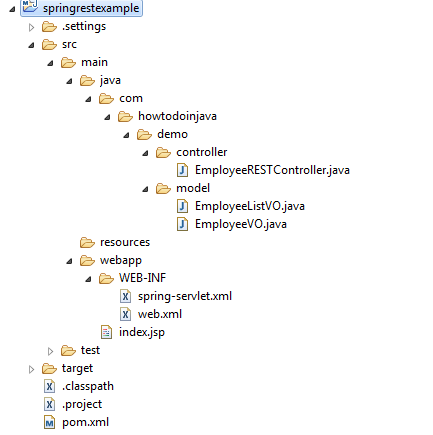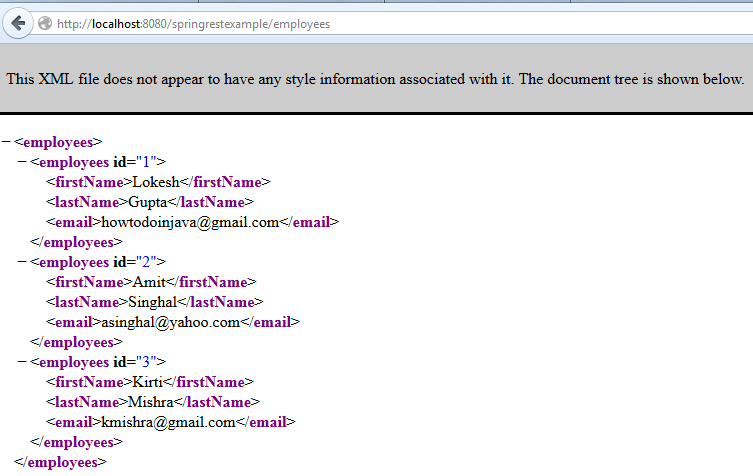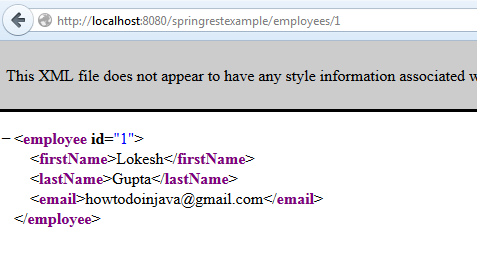In this tutorial, I am writing hello world example for RESTful APIs using Spring REST features. In this example, I will be creating two APIs which will return XML representation of resources.
Maven Dependencies
Let’s start with runtime dependencies which you will need to write these RESTFul APIs. In fact, all you need is Spring MVC support only.
pom.xml
<project xmlns="http://maven.apache.org/POM/4.0.0" xmlns:xsi="http://www.w3.org/2001/XMLSchema-instance"
xsi:schemaLocation="http://maven.apache.org/POM/4.0.0 http://maven.apache.org/maven-v4_0_0.xsd">
<modelVersion>4.0.0</modelVersion>
<groupId>com.howtodoinjava.demo</groupId>
<artifactId>springrestexample</artifactId>
<packaging>war</packaging>
<version>0.0.1-SNAPSHOT</version>
<name>springrestexample Maven Webapp</name>
<url>http://maven.apache.org</url>
<dependencies>
<dependency>
<groupId>junit</groupId>
<artifactId>junit</artifactId>
<version>4.12</version>
<scope>test</scope>
</dependency>
<!-- Spring MVC support -->
<dependency>
<groupId>org.springframework</groupId>
<artifactId>spring-webmvc</artifactId>
<version>4.1.4.RELEASE</version>
</dependency>
<dependency>
<groupId>org.springframework</groupId>
<artifactId>spring-web</artifactId>
<version>4.1.4.RELEASE</version>
</dependency>
<dependency>
<groupId>org.springframework</groupId>
<artifactId>spring-core</artifactId>
<version>4.1.4.RELEASE</version>
</dependency>
</dependencies>
<build>
<finalName>springrestexample</finalName>
</build>
</project>Note: If you please planning to include JSON support as well then all you need to do is include Jackson libraries into classpath, and same APIs will work for jackson as well.
<!-- Jackson JSON Processor -->
<dependency>
<groupId>com.fasterxml.jackson.core</groupId>
<artifactId>jackson-databind</artifactId>
<version>2.4.1</version>
</dependency>Spring MVC Configuration
For creating APIs, you will need to configure your applications same as you do in Spring MVC.
web.xml
<!DOCTYPE web-app PUBLIC
"-//Sun Microsystems, Inc.//DTD Web Application 2.3//EN"
"http://java.sun.com/dtd/web-app_2_3.dtd" >
<web-app>
<display-name>Archetype Created Web Application</display-name>
<servlet>
<servlet-name>spring</servlet-name>
<servlet-class>
org.springframework.web.servlet.DispatcherServlet
</servlet-class>
<load-on-startup>1</load-on-startup>
</servlet>
<servlet-mapping>
<servlet-name>spring</servlet-name>
<url-pattern>/</url-pattern>
</servlet-mapping>
</web-app>spring-servlet.xml
<beans xmlns="http://www.springframework.org/schema/beans"
xmlns:xsi="http://www.w3.org/2001/XMLSchema-instance"
xmlns:context="http://www.springframework.org/schema/context"
xmlns:mvc="http://www.springframework.org/schema/mvc"
xsi:schemaLocation="http://www.springframework.org/schema/beans
http://www.springframework.org/schema/beans/spring-beans.xsd
http://www.springframework.org/schema/context
http://www.springframework.org/schema/context/spring-context.xsd
http://www.springframework.org/schema/mvc
http://www.springframework.org/schema/mvc/spring-mvc.xsd">
<context:component-scan base-package="com.howtodoinjava.demo" />
<mvc:annotation-driven />
</beans>JAXB Annotated Model Objects
You will need to annotate your model objects with jaxb annotations so that JAXB can marshal the java object into XML representation to be sent to client for that API.
EmployeeVO.java
package com.howtodoinjava.demo.model;
import java.io.Serializable;
import javax.xml.bind.annotation.XmlAccessType;
import javax.xml.bind.annotation.XmlAccessorType;
import javax.xml.bind.annotation.XmlAttribute;
import javax.xml.bind.annotation.XmlElement;
import javax.xml.bind.annotation.XmlRootElement;
@XmlRootElement (name = "employee")
@XmlAccessorType(XmlAccessType.NONE)
public class EmployeeVO implements Serializable
{
private static final long serialVersionUID = 1L;
@XmlAttribute
private Integer id;
@XmlElement
private String firstName;
@XmlElement
private String lastName;
@XmlElement
private String email;
public EmployeeVO(Integer id, String firstName, String lastName, String email) {
super();
this.id = id;
this.firstName = firstName;
this.lastName = lastName;
this.email = email;
}
public EmployeeVO(){
}
//Setters and Getters
@Override
public String toString() {
return "EmployeeVO [id=" + id + ", firstName=" + firstName
+ ", lastName=" + lastName + ", email=" + email + "]";
}
}EmployeeListVO.java
package com.howtodoinjava.demo.model;
import java.util.ArrayList;
import java.util.List;
import javax.xml.bind.annotation.XmlRootElement;
@XmlRootElement (name="employees")
public class EmployeeListVO implements Serializable
{
private static final long serialVersionUID = 1L;
private List<EmployeeVO> employees = new ArrayList<EmployeeVO>();
public List<EmployeeVO> getEmployees() {
return employees;
}
public void setEmployees(List<EmployeeVO> employees) {
this.employees = employees;
}
}REST Controller
This is main class which will decide that which API will behave which way.
EmployeeRESTController.java
package com.howtodoinjava.demo.controller;
import org.springframework.http.HttpStatus;
import org.springframework.http.ResponseEntity;
import org.springframework.web.bind.annotation.PathVariable;
import org.springframework.web.bind.annotation.RequestMapping;
import org.springframework.web.bind.annotation.ResponseBody;
import org.springframework.web.bind.annotation.RestController;
import com.howtodoinjava.demo.model.EmployeeListVO;
import com.howtodoinjava.demo.model.EmployeeVO;
@RestController
public class EmployeeRESTController
{
@RequestMapping(value = "/employees")
public EmployeeListVO getAllEmployees()
{
EmployeeListVO employees = new EmployeeListVO();
EmployeeVO empOne = new EmployeeVO(1,"Lokesh","Gupta","howtodoinjava@gmail.com");
EmployeeVO empTwo = new EmployeeVO(2,"Amit","Singhal","asinghal@yahoo.com");
EmployeeVO empThree = new EmployeeVO(3,"Kirti","Mishra","kmishra@gmail.com");
employees.getEmployees().add(empOne);
employees.getEmployees().add(empTwo);
employees.getEmployees().add(empThree);
return employees;
}
@RequestMapping(value = "/employees/{id}")
public ResponseEntity<EmployeeVO> getEmployeeById (@PathVariable("id") int id)
{
if (id <= 3) {
EmployeeVO employee = new EmployeeVO(1,"Lokesh","Gupta","howtodoinjava@gmail.com");
return new ResponseEntity<EmployeeVO>(employee, HttpStatus.OK);
}
return new ResponseEntity(HttpStatus.NOT_FOUND);
}
}Let’s note down few important things.
1) We have used @RestController annotation. Till Spring 3, we would have been using @Controller annotation and in that case it was important to use @ResponseBody annotation as well. e.g.
@Controller
public class EmployeeRESTController
{
@RequestMapping(value = "/employees")
public @ResponseBody EmployeeListVO getAllEmployees()
{
//API code
}
}Spring 4 introduced @RestController which is combination of @Controller + @ResponseBody. So when using @RestController you do not need to use @ResponseBody. It’s optional.
2) Here we are relying on the Spring MVC HttpMessageConverters to convert an object to the xml representation requested by the user. @ResponseBody annotation (included through @RestController) tells Spring MVC that the result of the method should be used as the body of the response. As we want XML this marshaling is done by the Jaxb2RootElementHttpMessageConverter provided by Spring which is automatically registered in spring context if JAXB libraries are found in classpath. As I am using JRE 7 to run this application and it has JAXB inbuilt, so I do not need to add external dependency through maven.
3) Due to the @ResponseBody annotation, we don’t need the view name anymore but can simply return the employees object.
4) Instead of returning the java objects directly, you can wrap them inside ResponseEntity. The ResponseEntity is a class in Spring MVC that acts as a wrapper for an object to be used as the body of the result together with a HTTP status code. This provides greater control over what you are returning to client in various use cases. e.g. returning a 404 error if no employee is found for given employee id.
Project Structure
Test the APIs
Let’s test above REST APIs.
1) Hit URL : http://localhost:8080/springrestexample/employees
You can pass accept header “application/xml” as well.
2) Hit URL : http://localhost:8080/springrestexample/employees/1
3) Hit URL : http://localhost:8080/springrestexample/employees/123
Status Code: 404 Not Found
Content-Length: 0
Date: Fri, 18 Feb 2015 07:01:17 GMT
Server: Apache-Coyote/1.1That’s all for this quick hello world application for RESTFul APIs using spring mvc.

























 1498
1498

 被折叠的 条评论
为什么被折叠?
被折叠的 条评论
为什么被折叠?








